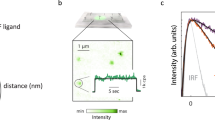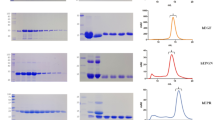Abstract
An interplay between monomeric and dimeric forms of human epidermal growth factor (EGF) affecting its interaction with EGF receptor (EGFR) is poorly understood. While EGF dimeric structure was resolved at pH 8.1, the possibility of EGF dimerization under physiological conditions is still unclear. This study aimed to describe the oligomeric state of EGF in a solution at physiological pH value. With centrifugal ultrafiltration followed by blue native gel electrophoresis, we showed that synthetic human EGF in a solution at a concentration of 0.1 mg/ml exists mainly in the dimeric form at pH 7.4 and temperature of 37 °C, although a small fraction of its monomers was also observed. Based on bioinformatics predictions, we introduced the D46G substitution to examine if EGF C-terminal part is directly involved in the intermolecular interface formation of the observed dimers. We found a reduced ability of the resulting EGF D46G dimers to dissociate at temperatures up to 50 °C. The D46G substitution also increased the intermolecular antiparallel β-structure content within the EGF peptide in a solution according to the CD spectra analysis that was confirmed by HATR-FTIR results. Additionally, the energy transfer between Tyr and Trp residues was detected by fluorescence spectroscopy for the EGF D46G mutant, but not for the native EGF. This allowed us to suggest the elongation and rearrangement of the intermolecular β-structure that leads to the observed stabilization of EGF D46G dimers. The results imply EGF dimerization under physiological pH value and temperature and the involvement of EGF C-terminal part in this process.







Similar content being viewed by others
Data Availability
The datasets used and analyzed during the current study are available from the corresponding author on reasonable request.
Code Availability
Not applicable.
Abbreviations
- BN-PAGE:
-
Blue native polyacrylamide gel electrophoresis
- EGF:
-
Epidermal growth factor
- EGFR:
-
Epidermal growth factor receptor
- CD:
-
Circular dichroism;
- MWCO:
-
Molecular weight cut-off
- NMR:
-
Nuclear magnetic resonance
- PB:
-
Phosphate buffer
- HATR-FTIR:
-
Horizontal attenuated total reflection Fourier transform infrared spectroscopy
References
Carpenter G, Cohen S (1979) Epidermal growth factor. Annu Rev Biochem 48:193–216. https://doi.org/10.1146/annurev.bi.48.070179.001205
Lu HS, Chai JJ, Li M, Huang BR, He CH, Bi RC (2001) Crystal structure of human epidermal growth factor and its dimerization. J Biol Chem 276(37):34913–34917. https://doi.org/10.1074/jbc.M102874200
Huang HW, Mohan SK, Yu C (2010) The NMR solution structure of human epidermal growth factor (hEGF) at physiological pH and its interactions with suramin. Biochem Biophys Res Commun 402(4):705–710. https://doi.org/10.1016/j.bbrc.2010.10.089
Zanetti-Domingues LC, Korovesis D, Needham SR, Tynan CJ, Sagawa S, Roberts SK et al (2018) The architecture of EGFR’s basal complexes reveals autoinhibition mechanisms in dimers and oligomers. Nat Commun 9(1):4325. https://doi.org/10.1038/s41467-018-06632-0
Yu X, Sharma KD, Takahashi T, Iwamoto R, Mekada E (2002) Ligand-independent dimer formation of epidermal growth factor receptor (EGFR) is a step separable from ligand-induced EGFR signaling. Mol Biol Cell 13(7):2547–2557. https://doi.org/10.1091/mbc.01-08-0411
Marianayagam NJ, Sunde M, Matthews JM (2004) The power of two: protein dimerization in biology. Trends Biochem Sci 29(11):618–625. https://doi.org/10.1016/j.tibs.2004.09.006
Lu C, Mi LZ, Grey MJ, Zhu J, Graef E, Yokoyama S et al (2010) Structural evidence for loose linkage between ligand binding and kinase activation in the epidermal growth factor receptor. Mol Cell Biol 30(22):5432–5443. https://doi.org/10.1128/MCB.00742-10
Ogiso H, Ishitani R, Nureki O, Fukai S, Yamanaka M, Kim JH et al (2002) Crystal structure of the complex of human epidermal growth factor and receptor extracellular domains. Cell 110(6):775–787. https://doi.org/10.1016/s0092-8674(02)00963-7
Gallay J, Vincent M, Li de la Sierra IM, Alvarez J, Ubieta R, Madrazo J et al (1993) Protein flexibility and aggregation state of human epidermal growth factor. A time-resolved fluorescence study of the native protein and engineered single-tryptophan mutants. Eur J Biochem 211(1–2):213–219. https://doi.org/10.1111/j.1432-1033.1993.tb19888.x
Jacob J, Duclohier H, Cafiso DS (1999) The role of proline and glycine in determining the backbone flexibility of a channel-forming peptide. Biophys J 76(3):1367–1376. https://doi.org/10.1016/S0006-3495(99)77298-X
Wittig I, Braun HP, Schägger H (2006) Blue native PAGE. Nat Protoc 1(1):418–428. https://doi.org/10.1038/nprot.2006.62
Hirota S, Hattori Y, Nagao S, Taketa M, Komori H, Kamikubo H et al (2010) Cytochrome c polymerization by successive domain swapping at the C-terminal helix. Proc Natl Acad Sci USA 107(29):12854–12859. https://doi.org/10.1073/pnas.1001839107
Kozlowski LP (2021) IPC 2.0: prediction of isoelectric point and pKa dissociation constants. Nucleic Acids Res 49(W1):W285–W292. https://doi.org/10.1093/nar/gkab295
Micsonai A, Wien F, Bulyáki É, Kun J, Moussong E, Lee YH et al (2018) BeStSel: a web server for accurate protein secondary structure prediction and fold recognition from the circular dichroism spectra. Nucleic Acids Res 46(W1):W315–W322. https://doi.org/10.1093/nar/gky497
Lakowicz JR (2006) Principles of fluorescence spectroscopy. Springer, New York, p 954
Broos J, Tveen-Jensen K, de Waal E, Hesp BH, Jackson JB, Canters GW et al (2007) The emitting state of tryptophan in proteins with highly blue-shifted fluorescence. Angew Chem Int Ed Engl 46(27):5137–5139. https://doi.org/10.1002/anie.200700839
Yang J, Zhang Y (2015) I-TASSER server: new development for protein structure and function predictions. Nucleic Acids Res 43(W1):W174–W181. https://doi.org/10.1093/nar/gkv342
Xu D, Zhang Y (2013) Toward optimal fragment generations for ab initio protein structure assembly. Proteins 81(2):229–239. https://doi.org/10.1002/prot.24179
Shen Y, Maupetit J, Derreumaux P, Tufféry P (2014) Improved PEP-fold approach for peptide and miniprotein structure prediction. J Chem Theory Comput 10(10):4745–4758. https://doi.org/10.1021/ct500592m
Deng H, Jia Y, Zhang Y (2016) 3Drobot: automated generation of diverse and well-packed protein structure decoys. Bioinformatics 32(3):378–387. https://doi.org/10.1093/bioinformatics/btv601
Doig AJ, MacArthur MW, Stapley BJ, Thornton JM (1997) Structures of N-termini of helices in proteins. Protein Sci 6(1):147–155. https://doi.org/10.1002/pro.5560060117
Khrustalev VV, Khrustaleva TA, Poboinev VV, Stojarov AN, Kordyukova LV, Akunevich AA (2021) Spectra of tryptophan fluorescence are the result of co-existence of certain most abundant stabilized excited state and certain most abundant destabilized excited state. Spectrochim Acta A Mol Biomol Spectrosc 257:119784. https://doi.org/10.1016/j.saa.2021.119784
Hristova SH, Zhivkov AM (2019) Isoelectric point of free and adsorbed cytochrome c determined by various methods. Colloids Surf B Biointerfaces 174:87–94. https://doi.org/10.1016/j.colsurfb.2018.10.080
Greenfield NJ (2006) Using circular dichroism spectra to estimate protein secondary structure. Nat Protoc 1(6):2876–2890. https://doi.org/10.1038/nprot.2006.202
Whitmore L, Wallace BA (2008) Protein secondary structure analyses from circular dichroism spectroscopy: methods and reference databases. Biopolymers 89(5):392–400. https://doi.org/10.1002/bip.20853
Sadat A, Joye IJ (2020) Peak fitting applied to fourier transform infrared and Raman spectroscopic analysis of proteins. Appl Sci 10:5918. https://doi.org/10.3390/app10175918
Barth A (2007) Infrared spectroscopy of proteins. Biochim Biophys Acta 1767:1073–1101. https://doi.org/10.1016/j.bbabio.2007.06.004
Vivian JT, Callis PR (2001) Mechanisms of tryptophan fluorescence shifts in proteins. Biophys J 80(5):2093–2109. https://doi.org/10.1016/S0006-3495(01)76183-8
Teng Q (2005) Structural biology: practical NMR applications. Springer, New York, p 295
Ferguson KM, Berger MB, Mendrola JM, Cho HS, Leahy DJ, Lemmon MA (2003) EGF activates its receptor by removing interactions that autoinhibit ectodomain dimerization. Mol Cell 11(2):507–517. https://doi.org/10.1016/s1097-2765(03)00047-9
Marqueze-Pouey B, Mailfert S, Rouger V, Goaillard JM, Marguet D (2014) Physiological epidermal growth factor concentrations activate high affinity receptors to elicit calcium oscillations. PLoS ONE 9(9):e106803. https://doi.org/10.1371/journal.pone.0106803
Khrustalev VV, Khrustaleva TA, Kahanouskaya EY, Rudnichenko YA, Bandarenka HV, Arutyunyan AM et al (2018) The alpha helix 1 from the first conserved region of HIV1 gp120 is reconstructed in the short NQ21 peptide. Arch Biochem Biophys 638:66–75. https://doi.org/10.1016/j.abb.2017.12.004
Carugo O (2014) Buried chloride stereochemistry in the Protein Data Bank. BMC Struct Biol 14:19. https://doi.org/10.1186/s12900-014-0019-8
Funding
This work was supported by the Belarusian Republican Foundation for Fundamental Research [Grant Number B20M-025].
Author information
Authors and Affiliations
Contributions
AAA: Investigation, Formal analysis, Writing—Original draft preparation, Visualization. VVK: Conceptualization, Investigation, Formal analysis, Writing—Original draft preparation. TAK: Conceptualization, Investigation, Supervision, Writing—Review and editing. VVP: Investigation, Formal analysis, Writing—Review and editing. NVS: Methodology, Investigation, Writing—Review and editing. ANS: Methodology, Investigation, Writing—Review and editing. AMA: Investigation, Writing—Review and editing. LVK: Investigation, Writing—Review and editing. YGS: Methodology, Investigation.
Corresponding author
Ethics declarations
Conflict of interest
The authors have no conflicts of interest to declare that are relevant to the content of this article.
Additional information
Publisher's Note
Springer Nature remains neutral with regard to jurisdictional claims in published maps and institutional affiliations.
Supplementary Information
Below is the link to the electronic supplementary material.
Rights and permissions
About this article
Cite this article
Akunevich, A.A., Khrustalev, V.V., Khrustaleva, T.A. et al. Equilibrium Between Dimeric and Monomeric Forms of Human Epidermal Growth Factor is Shifted Towards Dimers in a Solution. Protein J 41, 245–259 (2022). https://doi.org/10.1007/s10930-022-10051-y
Accepted:
Published:
Issue Date:
DOI: https://doi.org/10.1007/s10930-022-10051-y




